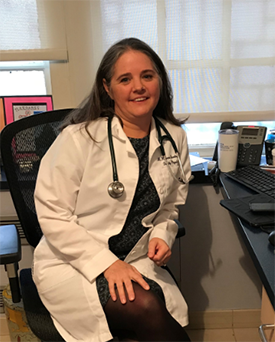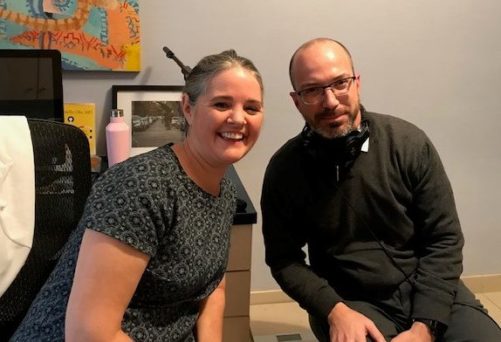Provider Spotlight
Cultural Medicine, Coast to Coast: MSHP Spotlight on CIN Family Medicine Provider, Dr. Margaret Kearns-Stanley
We sat down with Dr. Margaret Kearns-Stanley, a family medicine physician on the Upper East Side, to discuss her journey as a physician, her passion for family medicine, and how treating people as individuals with an understanding of their culture is critical to keeping them healthy.
Dr. Kearns-Stanley grew up on Long Island in what she described as a service-oriented family and spent a year working with relocated Native Americans in Oakland with the Jesuit Volunteer Corps before earning her MD from the State University of New York, Stony Brook and completing her residency in family practice at Beth Israel Medical Center.
When Dr. Kearns-Stanley was 8 years old, her grandmother was diagnosed with lung cancer and it was that experience that led Dr. Kearns-Stanley to the pre-med track as an undergrad. But she says it was the time she spent in Oakland that really shaped her career and her approach to medicine.

From Oakland to the Upper East Side, Cultural Medicine Remains Central
As Dr. Kearns-Stanley describes, the Jesuit Volunteer Corps was similar to the Peace Corps in that volunteers lived in the community they worked in, and worked in various service roles. She worked in the health clinic performing triage, patient education, quality reporting, and other similar tasks. The patients she served had just been removed from their homes on reservations as part of a federal government initiative to move indigenous peoples into urban areas, in what was an isolating, traumatic experience for many, and a necessary, if not always desirable experience for others.
An Introduction to Cultural Medicine
This diverse community of several different tribes also suddenly had no health care (whereas they had universal healthcare on reservations) and high incidences of alcoholism, hypertension, and diabetes. “This was when I learned a lot about cultural medicine,” said Dr. Kearns-Stanley. “It was a very eye-opening experience. I grew up in the suburbs of New York in a very white community and had never met Native Americans. I was a very young looking white girl and it was challenging to get them to trust me.”
Food as a Determinant of Health
As she led classes on diabetes for a community for whom fry bread was a part of their culture, she realized doctors can’t simply tell people to eat more vegetables; they need to find out what works for them. Even now, practicing on the Upper East Side, she notes food continues to be central to health. “On the Upper East Side, anorexia is a big challenge for people. How people eat, who they eat with, what they eat, are all big parts of their health. It is one thing that really impacts us all. You need to understand where people are coming from culturally if you want to influence their health.”
“They worked hard to educate me,” Dr. Kearns-Stanley remembers. Despite her very different background from the community she was serving, it was their effort in teaching and sharing their culture with her and inviting her to eat with them that helped her learn how to effectively serve their needs and understand them as people with individual and cultural needs, not “just a body. In addition she noted that she read every Native American-authored novel she could to try to understand their experiences better.
This work in Oakland inspired her to practice family medicine and urban medicine specifically, despite the prevailing attitude she encountered when applying to medical school and in her rotations that family physicians were lesser than other specialties. “There was always the feeling that you had to prove yourself. It was a struggle. But 25 years later this is the way to be and place to be if we’re going to have any change in healthcare.”
Practicing Family Medicine in New York City
Her clientele on the Upper East Side of Manhattan is starkly different from the people she worked with in Oakland, but they are nonetheless diverse. “Everyone has a backstory,” she says. Her patients now include not just residents of her practice’s neighborhood, but the employees of the families that live there, people who commute on the subway from the Bronx and Brooklyn because, in their eyes, seeing a doctor on Park Avenue means seeing a “good” doctor.
Crucial to her practice today is her relationship with her patients and treating individuals as a part of a community that affects their health. She has very few staff and does nearly everything herself, from ordering vaccines to taking patients’ height and weight. This affords her more time to spend with her patients, not only to develop a more robust relationship with them but to gather more information from them that can be helpful in diagnosing and treating them.

“Patients never tell you the whole story at the beginning,” she says, “They always remember something else. This way I’m gathering information from them the whole time. I’m seeing what they’re anxious about, what comes out later.” She notes that the overwhelming majority of her patients find this to be a much better experience, as well. “One thing people are craving is relationships, in all aspects of life.” Patients who are unfamiliar with family physicians or do not have a regular primary care doctor (particularly those who are relatively young and relatively healthy) may not realize that they are missing out on this relationship until they have a bigger health problem.
She says, “I know I can’t solve all of their problems but I can hear them and listen to them. That’s what it means to be a family doctor. Making sure they are heard so I can bring them to the right person. We’re unique…in that we treat the person as part of a bigger community that impacts their health.”
Click here to view all of our provider spotlights or visit our News & Media page for all of our newsletters, podcasts, and spotlights.
